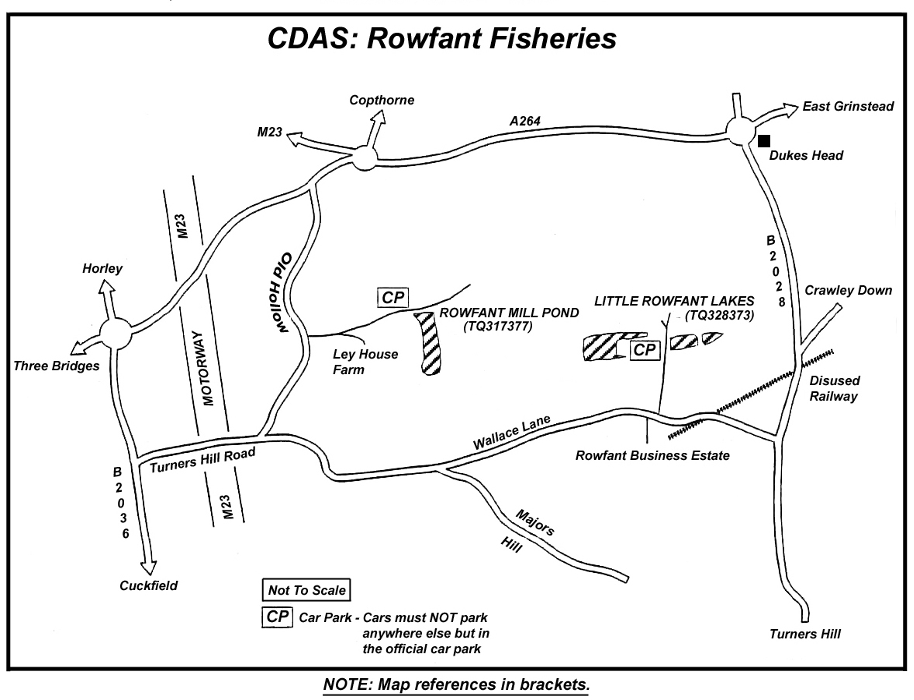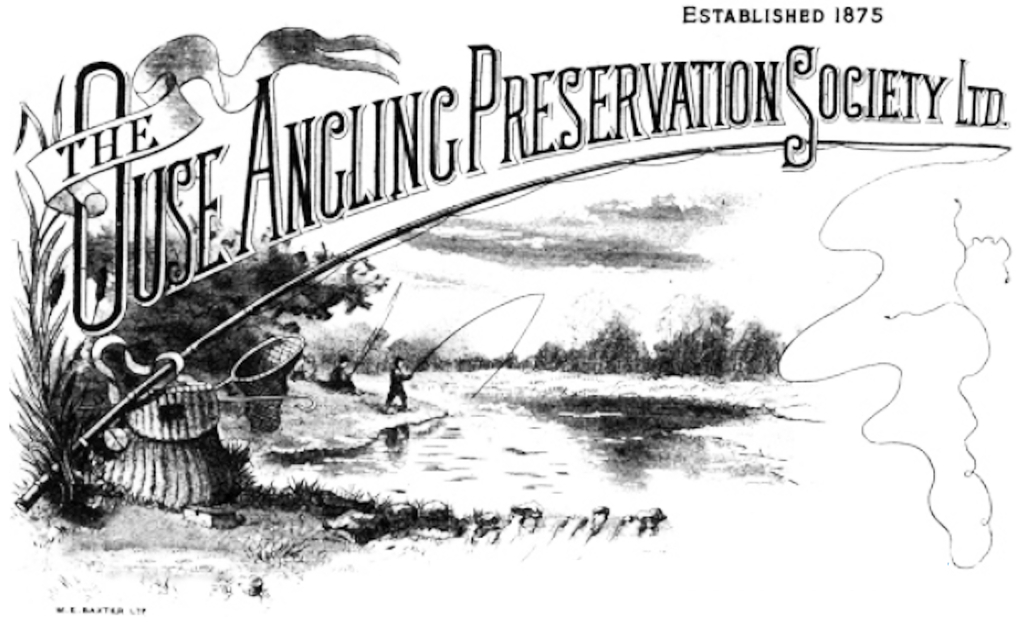
INFORMATION, RULES & GUIDE TO WATERS
Information for the 2024/2025 Season
· The Bevern stream reopens in a limited capacity – To protect this valuable sea trout spawning and nursery area there is to be no bait fishing with worms, maggots, casters, also spinning remains prohibited. Minimum hook size on the Bevern 6.
· OAPS are pleased to announce the new carpark at the anchor, please see the website for more information
· Amendment to pike fishing rules. Pike fishing with fly and lure will commence from the 1st October in 2024. Dead bait fishing to recommence 1st November.
· The committee have been alarmed by reports of completely inappropriate rigs that have found deep in the throats of some captured pike over recent times. Though we acknowledge that this might not have been committed by anglers fishing the OAPS bank we will be upping our bailiff attention in this area. The following changes are now in force. Minimum wire trace strength 30lb. Minimum mainline strength braid 50lb, mono 20lb. This applies to spinning and dead baiting
·
GENERAL INFORMATION
· Ouse Angling Preservation Society (O.A.P.S.) and Copthorne and District Angling Society (C.D.A.S.) have a water sharing agreement.
· O.A.P.S. Annual permits are valid on C.D.A.S. waters and C.D.A.S. Members are permitted to fish O.A.P.S. waters.
· Closed Seasons:
o Rivers
o Coarse Fish – 15th March to 15th June inclusive.
o Sea Trout – 1st November to 30th April inclusive.
o Stillwaters (C.D.A.S.)
o No Closed Season.
· Adult and senior permit holders are requested to report any infringements of the Society’s rules to the Hon. Secretary or email the Society through our website.
· All anglers must read the health and safety warnings on page 10 and exercise reasonable care regarding their own safety and that of others. Please contact the Hon. Secretary or email the Society through our website to advise of any hazards you may encounter when fishing which could lead to a claim being made against our liability insurance.
· The combination number for ALL Society’s padlocks is shown on the front of your permit and on the back of your permit for ALL C.D.A.S. padlocks.
· Permit holders are expected to behave in a sportsmanlike manner and to observe the Country Code - you will be held responsible for any loss or damage you cause.
o Care must be taken when opening and closing gates.
o As a rule, all gates should be left as they were found, however those giving access to the river from roads should be closed, whether found open or not, especially where livestock are present.
· Permit holders can email the Society at permitholder@ouseaps.co.uk and have their email address added to our list of contacts in case any urgent information needs to be passed on.
When emailing please include your name, plus your permit number and the name of the outlet you bought it from so we can confirm that you are a permit holder.
Please note: Your email address will only be used for the Society to contact you and will not be passed on to any third parties. Your email address can be removed from our list of contacts at any time all you need do is email a request to remove it.
RULES
A. Permits
1. The purchase of an Ouse Angling Preservation Society (O.A.P.S.) Annual constitutes a contract to observe the Society’s rules.
2. Annual Permits
a. Anglers must have the appropriate O.A.P.S. Annual and an Environment Agency rod license in their possession before fishing – see rule 4 (below) for under 14s.
b. A current Sea Trout Permit and current Salmon & Sea Trout rod license are required to fish for Sea Trout.
3. Guest permits (these allow access to O.A.P.S. controlled waters ONLY.)
a. Adult, Senior holders may buy up to two Coarse Fishing Guest permits per day at a cost of £10.00 for adults and £5.00 for under 19s.
b. Guest permits must be purchased in advance of fishing from the Society’s Permit Secretary or permit outlets.
c. Sea Trout Fishing Guest permits are available from the Society’s Permit Secretary – details in the Sea Trout permit holders’ supplementary information pack.
d. Guest(s) must always be accompanied by the permit holder.
e. The permit holder will be held responsible for the actions of their guest(s) and should ensure that the Society’s rules are not broken.
4. Under 14s
a. Anglers under the age of 14 years may fish our waters free, provided they are always accompanied by an Adult permit holder
b. Please note that a valid Environment Agency rod license must be carried by all anglers aged 12 years and over.
5. The Society requires all anglers on its waters to abide by both the Environment Agency National and Southern Region Fishery Byelaws.
6. The Society reserves the right to refuse, cancel or withdraw any permit at the discretion of the Committee.
7. Permits are not transferable.
B. Fishing
1. Coarse fishing is not permitted in the Mill Pool and surrounding streams – the area within the circuit of roads formed by the Barcombe Mills Road and the Old Toll Road – under any circumstances during the months of May through October (signs are in place at several locations in the area.)
During this period, this area is ONLY available to Sea Trout Annual permit holders who are also in possession of a Pool permit valid for the day they are fishing.
ANY breach of this rule is considered very serious and will be dealt with accordingly.
Please Note: Coarse fishing is permitted here from 1st November until, and including, the following 14th March (the last day of the Sea Trout fishing season is 31st October).
2. Fishing is not allowed in the fish ladder between the New Weir (to the east of the Barcombe Mills sluice gates) and where it enters the Mill Pool.
3. Wading is not allowed in the Andrew’s Stream
4. Fishing for Sea Trout during the Coarse fishing closed season is only permitted with artificial lures and flies.
5. As part of the agreement for the Society to acquire the fishing rights, there are limits to the numbers of anglers who can fish in two areas at Barcombe Mills…
a. The field (marked as “Field A” on the map on page 9 to the south of Barcombe reservoir (bordering the main river from the reservoir, south to where it joins the Andrew’s Cut, together with the north bank of the Andrew’s Cut):
A maximum of 12 anglers to be fishing at any one time.
b. The two fields (marked as “Field B” and “Field C” on the map on page 9 separated by a drain and bounded to the north by the Andrew’s Cut from Andrew’s weir, west to the first gate and to the south and east by Andrew’s Stream as far as Pike’s Bridge (the Old Toll Road):
A maximum of 6 anglers to be fishing at any one time
If either of these maximums have been reached before you arrive, do not fish these areas until numbers allow.
6. Night fishing and overnight stays are not permitted on the Society’s waters.
a. No fishing is allowed between one hour after sunset and one hour before sunrise, except at the Mill Pool when fishing for Sea Trout on a Pool permit.
b. All waters and car parks MUST be vacated outside of this period.
7. The following are not permitted when fishing on the Society’s waters:
a. Fishing with more than two rods at any one time. Those two rod butts maximum 3m apart
b. Live baiting is not permitted on OAPS waters
c. The deliberate foul-hooking of fish.
d. Fishing from boats.
8. Anglers must not take dogs, light fires, create a disturbance that can be heard by other anglers or leave litter when fishing.
9. Anglers must not drive along the riverbanks,
C. Tackle
1. The following restrictions on items of fishing tackle apply on the Society’s waters…
a. Coarse Permit anglers fishing downstream of the Anchor Inn farm bridge must take note of the following rule if lure fishing, to minimize the accidental capture of, and stress to, the river’s Sea Trout…
Artificial lures — spinners, spoons, plugs and flies (excluding dry flies) — must be a MINIMUM of 12.5cm in length, including hooks, during the Sea Trout Fishing season (1st Oct to 31st October inclusive.)
Annual Coarse Fishing permits show a 12.5 cm measure for you to check lures against.
No barbed hooks to be used: In the case of artificial lures and spinners, either replace any barbed hooks with semi barbed ones OR squeeze the barb down to render the hook barbless – maximum size 8 or 10 hooks are recommended to limit any damage to the fish
1.
2. Keepnets, Keep sacks and Landing Nets
a. These must all comply with the current Environment Agency National Fishery Byelaws.
b. The Society discourages the use of keepnets but recognizes that there may be occasions where anglers would wish to use one.
To help maintain a stock of healthy fish in the river, NO fish weighing 3lb or more and no carp, pike or barbel of ANY weight shall be put into keepnets.
c. Environment Agency National Fishery Byelaws ban the keeping of more than one fish in a single keep sack.
D. Fish
1. Sea Trout: Any angler who accidentally catches a Sea Trout or Smolt, must send or email a Sea Trout Catch Return to provide the Society with the length and weight of the fish, plus place, method (lure, fly, bait) and date of capture.
Additional rules covering capture by Sea Trout anglers are set out in the supplementary Sea Trout information pack issued with the Sea Trout Annual permit.
2. Pike: To avoid any stress to pike during the warmer months, OAPS has decided that there will be no pike fishing before 1st October
Anglers either fishing for or using a fishing method likely to catch pike must use a hook trace material, with a minimum breaking 30lb breaking strain, that will prevent line being bitten through. Leaving hooks or lures in pike can kill them. Mainline should be of 50lb braid or 20lb mono as a minimum.
The Sussex Ouse contains a substantial pike population with many weighing 20lb+ and some in excess of 30lb. Contrary to its appearance, the pike is not the most robust of fish and can be damaged if not fished for and/or handled correctly.
It is essential that, if you are fishing using a method likely to hook pike or are fishing for them, the tackle you use gives you the best chance of landing your fish.
Anglers fishing specifically for pike should ensure that they use specialist pike fishing tackle which will handle the size of fish they are likely to encounter and, most importantly, anglers fishing for pike should, at all times, use some form of modern wire (or other) trace to prevent line being bitten through and leaving hooks or lures in fish.
Modern trace material such as Drennan Soft Strand can easily be knotted and made into short traces which, while protecting pike, are very unobtrusive and do not affect the action of even the smallest lures. Society Committee members have used such traces and found they have no adverse effect on either catch rate or lure action.
Once a pike has been hooked, it needs to be landed as quickly as possible, then handled with care and confidence during unhooking to minimize any stress before being returned to the water with the minimum of delay.
There are resources on the internet and many books available about pike fishing. Pike anglers, particularly those with limited experience, are advised to familiarize themselves with all aspects of this branch of our sport. The website of The Pike Anglers Club of Great Britain is a good starting point and can be found by following the ‘Angling Links’ menu on the Society’s website (www.ouseaps.co.uk). You will find a lot of advice here, both written and on video, on appropriate tackle, fish handling and fishing methods.
3. All native coarse fish species (including pike) must be returned to the water alive (but see the following rule concerning non-native species.)
4. Section 9 of The Wildlife and Countryside Act 1981 identifies several non-native species that it is illegal to return to the water if captured.
Pumpkinseed, Catfish and Signal Crayfish are known to be in the Sussex Ouse and tributaries and should not be returned to the water. The full list is on the Society’s website at www.ouseaps.co.uk
E. Parking
1. Parking labels must always be displayed when fishing including when parked at all Hamsey car parks, Culver, Cowlease farms and the anchor, the Society’s car park at Barcombe Mills and all C.D.A.S. car parks.
2. Parking is NOT allowed on the Old Toll Road that runs past the Mill Pool and sluice gates at Barcombe Mills. Please use the Society’s car park.
3. Overnight parking is allowed ONLY at the Society’s car park at Barcombe Mills and ONLY for Sea Trout permit holders in possession of a Pool permit covering the period when parked – overnight parking is NOT allowed at any of the Society’s other car parks.
4. Cars must NOT be left in front of any gateway or left where they could block any other access.
F. IMPORTANT WARNING!
In previous years, the Society had incidents of several things, including fruit, being taken from private land without permission by individuals claiming to be with O.A.P.S.
Should any permit holders, or those accompanying them, be identified as being involved in this activity, the Society will have no option but to take action that may include banning those concerned from fishing on our waters.
Be aware that this behaviour will not be tolerated!
GUIDE TO WATERS
River Ouse – The tidal river between Barcombe Mills and Hamsey.
The west bank of the river north from a point approximately 150 yards below the upstream end of Hamsey Cut (marked by a fence) to the Barcombe Mills road bridge. Also on Hamsey Island at Hamsey weir, and on the east bank of Hamsey Cut south from the bridge to the point where the Cut re-joins the main river then upstream along the main river as far as the first sluice gate - identifiable by a metal barrier around its top.
Signs usually mark the limits of our waters (although flooding may cause some to be missing from time to time) and our map shows the location of the following car parking and access points.
Car parking & access at Hamsey (main river.)
The Society has car parking with access through a padlocked gate (identified by the Society’s sign on the fence) on the northern side of Whitfield Lane.
There are two parking areas… The first is on the right, just inside the gate, for permit holders who would prefer not to take their cars along the access track - please be aware that during periods of wet weather and particularly during the autumn and winter the track can be very muddy and difficult to negotiate.
The second parking area is through another gate to the left at the end of the track (turn left when you reach the old railway track bed) and is marked with another of the Society’s signs. This must be closed and locked after entry and exit at all times. Anglers MUST NOT drive along the river or down to the river from the top of the old track bed.
Car parking & access at Hamsey Island.
There are two car parking areas on the island. The first, or LOWER car park is through the gate on the right, just over the bridge to the island. The second, or UPPER car park, is through the padlocked gate on the right of the road to the church, just before the top of the hill.
The UPPER and LOWER car parks are the ONLY places that permit holders can park on the island.
Do not park ANYWHERE beyond the UPPER car park.
Please be aware that there may be livestock loose in parking areas, that could cause damage to vehicles and take note of the following...
1. The gate to the field leading to Hamsey weir (next to the right hand bend at the bottom of the hill up to the church) is padlocked. Parking is not allowed on the land behind this gate under ANY circumstances.
2. The notice by the padlocked gate, which states “Private Land. No public right of way”, does not apply to permit holders.
Car parking & access at Cowlease Farm.
Follow the concrete track and continue through the farmyard down the track towards the river as far as a small copse where there is space to park 3 or 4 cars on the right. Continue on foot along the track to the river.
Car parking & access at Culver Farm.
There is a parking area (signed) on the right side of the track just over the old Railway Bridge; there is also a signed parking area on the right before reaching the bridge. Cars may be parked on the grass verge or on the hard standing if the track to the bridge is too muddy but do not obstruct the tractors etc which are also parked here.
There are three recommended routes to the river from Culver and they are signposted:
1) Continue forward over the bridge and at the corner of the second field (by the signposts) turn right along the edge of the field to the stile near the pillbox.
2) As above but on reaching the signposts follow the left edge of the field to the copse and then bear left to the stile at the end.
3) If parked on the bridge, walk back towards the farm buildings and take the track off to the right to join the old railway line. Turn right under the bridge and continue until you reach a signposted track on the left, which leads to a stile by the river.
If growing crops impede access to any of these routes at Cowlease or Culver farms then use your discretion as to how you reach the river but do not, under any circumstances, damage those crops.
Car parking & access at Barcombe Mills.
Cars should be left in the Society's car park and NOT on the slip road in front of the houses opposite or blocking the gateway to Station field. Access to the river is through the gate next to the Society’s sign at Station field (the field downstream of the main road bridge.)
River Ouse - The Barcombe Mills Pool and surrounding streams.
This area comprises the pools, rivers and streams bounded to the south by the main Barcombe Mills road and to the north by the old toll road and is reserved from 1st May to 31st October inclusive for the sole use of Sea Trout Annual permit holders and their guests who are in possession of valid Pool permits.
Coarse Fishing is available here from November 1st until March 14th to Coarse Fishing Annual permit holders, without reservation and at no additional charge. This permission may be withdrawn temporarily at the Society’s discretion if there are numbers of Sea Trout awaiting suitable conditions to run up-stream.
Car parking.
Parking is NOT allowed on the old Toll Road that runs past the Mill Pool and sluice gates at Barcombe Mills. Please use the Society’s car park.
River Ouse – Above Barcombe Mills.
Fishing is NOT allowed in the steps of the New Weir – the weir that flows under the old toll road and into the Mill Pool.
East bank – The main river upstream of the Mills as far as the boundary of the reservoir at the end of the first field over the bridge crossing the Andrew’s Cut.
Fishing is also available on the west bank of Andrew’s Stream upstream of Pike’s Bridge (the first bridge on the Old Toll Road) to Andrew's Weir; and both banks of Andrews Cut. The Society now has combination padlocks on the gate next to Pike's Bridge and on the gate on Andrew's Cut to the east of the footbridge.
Car parking & access.
For the east bank park in the Society’s car park at Barcombe Mills and access the river along the Sussex Ouse Valley Way footpath.
The Bevern Stream.
The Bevern stream reopens in a limited capacity – To protect this valuable sea trout spawning and nursery area there is to be no bait fishing with worms, maggots and casters, also spinning remains prohibited
As this area recovers following the pollution incident in late 2016 in the Plumpton Mill Stream, which is a tributary of the Bevern Stream, we will continue to monitor fish recovery closely.
Given the Bevern Stream is a known spawning area for most coarse fish and a significant route and spawning area for migrating Sea Trout, we feel that some protection particularly of the sea trout parr is necessary. Checks will continue to be carried out to assess the balance of the habitat as it recovers from the pollution and also assess numbers of fish and fry.
River Ouse – the Anchor Sluice.
East bank – the first field downstream from Anchor bridge past the sluice gates to the field boundary almost opposite the old oil mills.
Car parking: Please do not park in any parking associated with the Anchor Inn either the main or overflow car park.
The Society now has a car park just before Keepers Cottage and the disused railway if you are heading towards the river, suitable for approximately 3 – 4 cars. The dimensions of this are tight so please park in a way that does not block anyone in and leaves room for other anglers if possible.
Please do not overfill this space. If already full you might be able to find space to park on verges before you reach the old railway crossing just before the Anchor Inn but be aware that there are deep ditches on either side of the road, and remember…
DO NOT Park in such a way that prevents lorries and tractors from passing.
DO NOT Block any gates or other access points.
DO NOT Park on the Anchor Inn forecourt OR in the car park opposite.
DO NOT Park on the farm track to Old Mill Farm OR on any land belonging to Old Mill Farm.
River Ouse - Sheffield Park
The Society has an agreement to share a stretch of the river at Sheffield Park with the Hayward’s Heath and District Angling Society (HHDAS).
The part of the river we are sharing is the right hand (west) bank of the river downstream from Sheffield Park road bridge on the A275 for approximately one mile indicated by the dotted line shown on the map below.
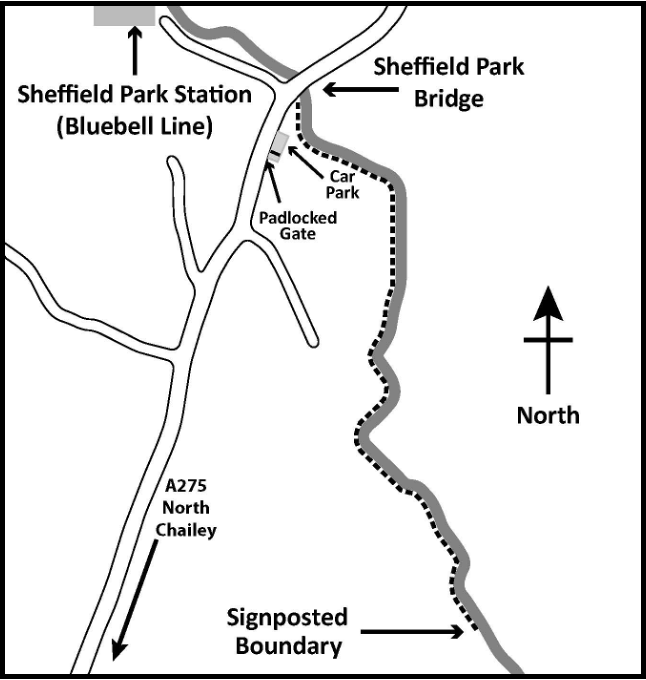
Directions:
From North Chailey where the A275 and A272 meet, take the A275 north towards Sheffield Park, approximately two miles away.
About 100yds before you reach the turning on the left into Sheffield Park Railway Station (The Bluebell Line) to the south (Chailey) side of Sheffield Park Bridge you will see a gate into the field on the right hand side of the road.
Parking is through this padlocked gate (the combination is 9231 please check with Permit Secretary if later in the Season – HHDAS do change the number) then through the gate immediately to the left and leave your car alongside the hedge. Please leave the padlock “daisy chained” to the other padlock
Access is across the field to the river with fishing downstream as far as the sign posted boundary and ALL of the Society's rules apply here, particularly the rule banning the lighting of fires.
PLEASE NOTE THAT DURING SCHOOL HOLIDAYS THE FIELD’S OWNER
ALLOWS IT TO BE USED AS A CAMPING SITE FROM TIME TO TIME.
For more details on this fishery check out the HHDAS website at hhdas.com
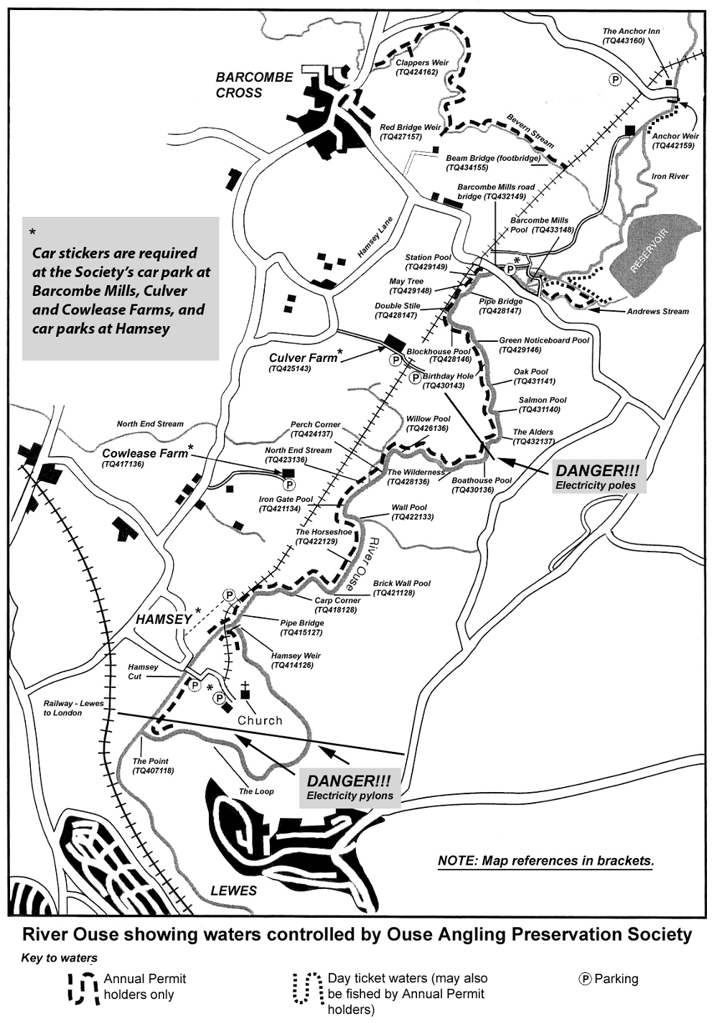
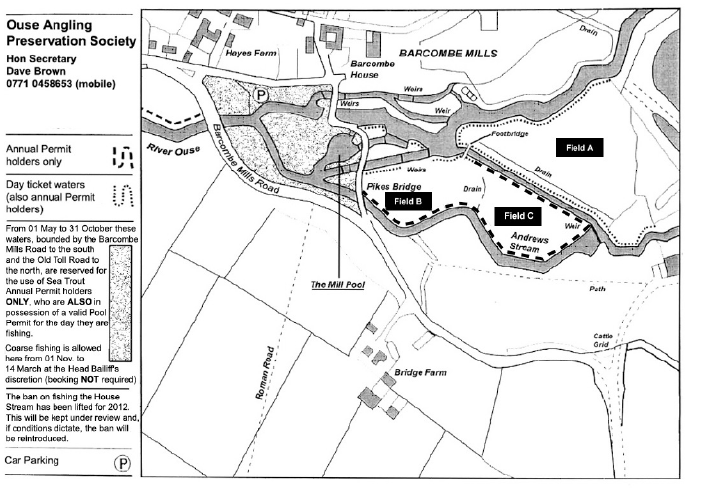
All anglers should read, and make sure they understand
the following Health and Safety information:
General
· Risk of electrocution: Electricity pylons cross the river at the southern end of Hamsey Cut, and at Goldbridge near Newick, and electricity poles cross the river at Culver farm. Anglers must take great care when fishing in these areas, as the high voltage cables they carry will deliver a potentially fatal shock if you get too close, or touch them.
· Discarded and lost tackle: Tackle should never be discarded at the fishery but should be taken home and disposed of appropriately to prevent injury to humans and wildlife.
· Weils disease (Leptospirosis): Anglers should be aware of this bacterial infection transmitted by rats’ urine, which is a serious disease in humans, requiring hospital treatment. All anglers should take sensible precautions, including:
o Covering any cuts, sores or scratches with waterproof plasters or gloves
o Disinfecting any wounds that occur at the waterside
o Washing hands or covering food with a wrapper before eating
o Not putting your hands in your mouth after immersing in river water and never placing bait or fishing line in your mouth
o Not touching any dead animals, especially rats
o Not leaving food, ground bait or bait on the bank
o If you do develop flu-like symptoms which persist, tell your doctor that you may have been exposed to Leptospirosis so that he/she can consider it in the diagnosis
· Rabies: Anglers fly fishing occasionally catch bats. If you do catch a bat, avoid touching it with your bare skin. If you think you may have been bitten or scratched, wash the wound immediately (preferably with soap, do NOT scrub the wound), and contact your doctor.
· Unhooking fish: Pike and perch have very sharp teeth, gills and gill covers. If they are not handled correctly, these can cause injury. The Society recommends that suitable forceps should be used, particularly when unhooking pike, and if you are an inexperienced pike angler you should fish with someone who is more experienced at handling them.
· Cattle: Cattle will often be found in fields bordering the river, and young, newly stocked cattle can be especially inquisitive. While they are not usually a danger, they can make fishing difficult at times, so it is generally better to detour around a herd, rather than attempt to walk through the centre of a group.
· Parking: Always park your car sensibly, so access for emergency vehicles is not blocked.
Fishing the river
· Remote locations: Much of the fishery is remote from habitation, so…
o Let a friend or family member know where you will be fishing, and when you expect to return home.
o Carry a mobile ‘phone (but do not assume there is reception all along the river).
o Map references (starting with TQ then a number) are shown on all maps to enable quick location by emergency services if necessary.
· Difficult banks: The River Ouse can be a dangerous river to fish:
o The banks of the tidal river (Barcombe Mills and downstream) can be very slippery, particularly after high tides.
o Some banks will be undermined and prone to collapse after flood and frost.
o The nature of the fishery makes it unsuitable for elderly or infirm anglers.
· Wading: Anglers are advised not to wade. If they do, the Society recommends that anglers wear an appropriate life preserver.
· Night Fishing: Due to the relatively difficult access to the water’s edge at the Barcombe Mill Pool and streams, sea trout anglers should exercise extreme care and unless very experienced in night fishing for sea trout are advised not to fish alone.
· Automatic Sluices: Sluice gates at Barcombe Mill Pool and the Anchor Weir are operated automatically when river flows increase. When open there is a very strong flow of water through the gates, with the attendant risk of being swept away. Anglers fishing the river in these locations should be aware of this potential hazard, which is signposted by the Environment Agency
If, while fishing the Society’s waters, you encounter any hazards not mentioned above, please report them immediately to the Hon. Secretary.
IMPORTANT NOTICE – LIABILITY INSURANCE
Following changes in the way insurance companies manage liability claims our insurers require the club to advise them immediately following incidents in which they may have an interest, particularly incidents involving personal injury. In order to comply with these changes any member who is involved in an incident whilst angling or on the fishery must immediately report the circumstances to the Hon. Secretary.
COPTHORNE AND DISTRICT ANGLING SOCIETY WATERS
*** Please note: O.A.P.S. Guest tickets cannot be used on any C.D.A.S waters ***
River Ouse – The Anchor Inn to Goldbridge (Newick)
A total length of fishing on the west bank of the river of approximately four miles.
HAZARD WARNING: For around a mile south of Goldbridge, the river is crossed by electricity pylons in several places. Be VERY careful when fishing in this area, as the pylons carry high voltage cables that will deliver a potentially fatal shock if you get too close.
From north of the Anchor Inn at Barcombe, upstream to Jack’s Point where the Longford Stream (Downstream on the south bank, from Longford Bridge on the Barcombe/Newick road as far as the confluence with the River Ouse at Jacks Point) enters the Ouse. Then from Bell Hole, where the River Uck mill race joins the Ouse upstream to Goldbridge, on the A272 east of Newick.
The fishing between Bell Hole and Jack’s Point is not available to permit holders.
Car parking & access to the river.
Goldbridge: Park in the lay-bys on both sides of the road to the east of the bridge. Go through the gate on the eastern downstream side of the road bridge and follow the river to the weir.
Sharpsbridge (on the Barcombe/Sharpsbridge/Piltdown road): Park on the verge by the footpath sign to the south of the houses by the bridge. Follow the footpath to the river
Vuggles Farm: On the Barcombe/Newick road, about three quarters of a mile north of Longford Bridge, on the right about 100yds before the turning to Sharpsbridge and Piltdown. Park on the grass verge on the left side of the road just before the duck pond. Access to the river is east along the hedge on the right hand side of the field behind the farm buildings (approx. 500yds). Please note: tractors use this lane so make sure you park well off the road.
The Anchor Inn: Difficulties with parking in the area of the Anchor Inn continue. See details for accessing this part of the river on page 6 of this Information Pack in the section headed “River Ouse – the Anchor Sluice.”
Rowfant Lakes: Copthorne and District Angling Society controls the fishing on the three Little Rowfant lakes and Rowfant Mill Pond (all between Turner’s Hill and Crawley).
Piltdown Pond: This is a mainly shallow 4 acre lake, with depths ranging from 2 - 5ft. It is a mixed fishery with a large head of fish including Carp, Pike, Tench, Bream, Crucians and Eels.
Rules specific to Piltdown Pond (make sure you are familiar with them BEFORE fishing)
1. No litter (anglers are responsible for any litter found in their swim.) 2. No fires. 3. No swimming.
4. No boating. 5. No intrusive noise. 6. No cutting of trees and/or vegetation.
7. Parking ONLY in the official car park. NO parking on the dam.
8. Fish must be returned unharmed to the pond as soon as possible.
9. The use of keep-nets/keep sacks is prohibited (unless on official match.)
10. Anglers must not leave their lines in the water unattended. 11. Baiting with live fish is prohibited.
12. Anglers must respect wildlife and follow the countryside code of conduct.
13. Anglers must hold a valid Environment Agency Angling Licence.
All permit holders are custodians of Piltdown Pond and have an obligation to ensure that they and others observe these Rules and Conditions.
Car Parking & Access: Take the A272 eastbound from Haywards Heath towards Uckfield. Between Newick and Maresfield take the right hand turn at Piltdown, just past the garage after passing the Piltdown Man pub. The pond is on the left after about 400m and the car park is just past the pond on the same side of the road.
For C.D.A.S. shared waters please refer to the maps on pages 12 and 13
to check location and car parking, and refer to your permit
for rules and combination padlock number.
Please note: Details of C.D.A.S. matches and the affected waters can be
found online at www.copthorneangling.co.uk
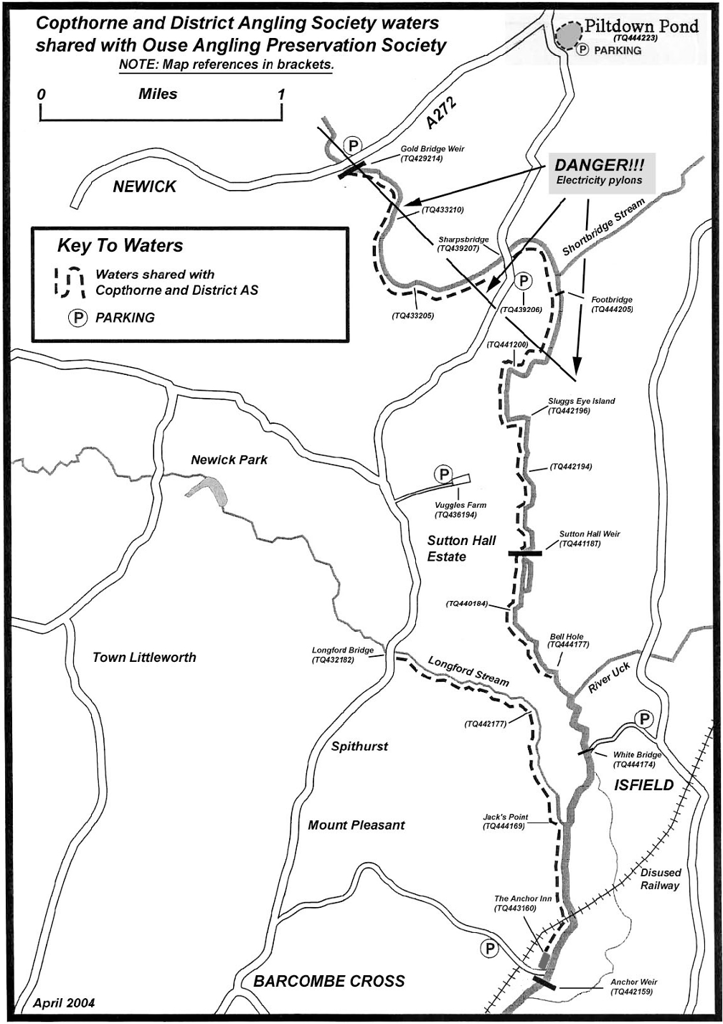
Copthorne and District Angling Society
